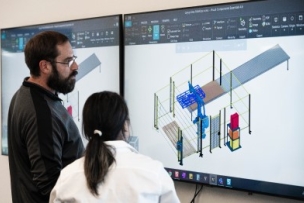Solutions to help you attract the best and brightest in the midst of the skills gap.
While opportunities abound, filling jobs in manufacturing is no easy task. The skills gap that exists in the industry threatens competitiveness collectively and individual companies specifically. Some 82 percent of the executives who responded in a 2015 survey by the Manufacturing Institute and Deloitte said they thought the skills gap would impact their ability to meet customer demands, and 78 percent said it could affect their ability to implement new technologies and increase productivity.
The shortage is across the board, although machinists and operators are “by far the biggest deficiency,” says Erik Kessinger, managing partner of Lucas Group’s manufacturing practice, who disclosed that his clients simply “cannot find enough skilled machinists to fill their open positions.”
Follow these steps to finding the best and brightest talent.
Create Strategic Alliances
Partnerships with local trade and technical schools can be effective, but what’s even more resourceful is when companies band together. The National Association of Manufacturers suggests creating an alliance with other regional manufacturers to create a larger employment pool and advocate for long-term solutions, which can garner additional attention from local government and educational institutions.
The National Association of Manufacturers Task Force on Competitiveness & the Workforce published “Overcoming the Manufacturing Skills Gap: A Guide for Building a Workforce-Ready Talent Pipeline in Your Community.” It states that the natural competition among manufacturers is often set aside to address this shared, urgent need. When alliances are formed, companies can focus disparate efforts and move the community from discussions to solutions.
Recruit Veterans
“In the military, young people get trained in skills like machining and operating highly technical equipment, which are very transferrable to the civilian sector,” says Kessinger. He suggests developing relationships with nearby military bases. You can also reach candidates by participating in local job fairs targeting veterans or working with a transition-assistance program for military personnel.
Develop Leadership-Training Programs
Fortune 500 manufacturers do this all the time, but now midmarket and smaller manufacturers are starting them, too, Kessinger says. These programs identify rising young talent (people with two to three years of work experience) and move them through all aspects of the business. Over two to four years, the candidates experience the supply chain, the manufacturing floor, sales and other areas, which allows both the employer and the young employee to discover where talents are strongest.
Launch a Campaign
Young people can overlook manufacturing as a career choice because they think only of coal and iron-riddled factories with declining opportunities and harsh working environments. They need to be informed that modern manufacturing uses cutting-edge technology like robotics, cloud computing and 3D printing.
Companies like Cleveland’s Lincoln Electric Holdings Inc. use virtual reality to test potential students’ welding abilities while demonstating the company’s sophistication as an industry innovator. Others have used online videos and smartphone apps to entice younger workers.
While small-business owners and executives may be easily distracted by the minutia of their daily struggles, it’s never too late to start planning for the future. Don’t let the skills-gap shortage leave your company in the dust; figure out ways to form alliances, go where skilled personnel already are and passionately promote the industry.
- Publicizing information about cutting-edge technology like robotics, cloud computing and 3D printing can make modern manufacturing more attractive.
- Develop in-house leadership-training programs.
- Forming business alliances can help you find skilled personnel who are already in the industry.






Talk to Us!
Maybe the "gap" between executive pay and blue collar workers could be narrowed.
39Thank you for your feedback.
38Finding people once hired(through probation) that perform and stay has been difficult as well.
45Thank you for visiting Better MRO.
41High schools in our area do not teach industrial arts like they once did.
This gave the student the opportunity to test the waters helping them decide if a field in the industrial arts was for them.
A lot of the 2 year Jr. colleges in our area have had to drop the trade classes because lack of interest. and I blame that on trying to get the students ready for a 4 year degree that will usually pay less than a trade.
We have had to hire people off the street and train them through on the lob training.
Of 4 Jr. colleges in our area when I went to see about recruiting students for employment.
the instructors had no one to send for job placement.
Dave
39Thank you for your valuable feedback.
37What i have noticed in the several year where i am currently employed is getting qualified people isn't the issue keeping them is. Companies need to invest in there work force as much as they do in any other facet of there company. Wage, Benefits, and problem resolution are the main reason that i have seen people leave and go elsewhere. Fix these issues and even a weak link can be reinforced to be stronger.
43Thanks for your feedback.
3935 years of experience in manual machining and CNC grinding late in my career in job shop companies only wanting button pushers.
42Thanks for visiting Better MRO and for your feedback.
40I have no pity for an industry which has dropped the ball - decades of poor wages, lack of training, lack of foresight for the future, fewer and fewer perks, nonexistent apprenticeship programs, etc etc..."What are we supposed to do?!?"...quit crying about the circumstances and DO SOMETHING ABOUT IT! It's disgusting watching what used to be the backbone of our country slip away.
40Well put Sam!!
41Thanks for visiting, Mark.
38Thank you for your feedback, Sam.
40Leave a reply
Your email address will not be published. Required fields are marked *